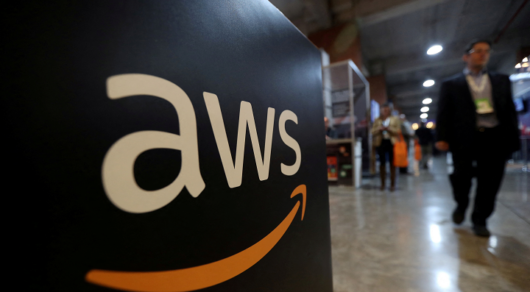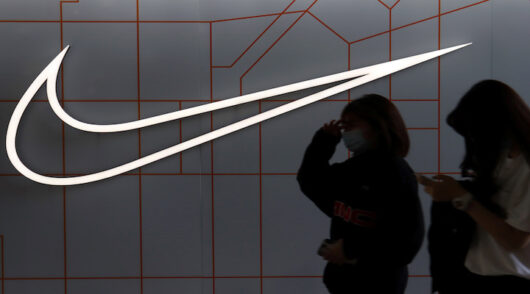In a supermarket in southern China, live fish swim around in a glass tank bearing a QR code for customers to scan for information about where the fish is from and details of provenance and sustainability in its farming or capture.
Welcome to the world of grocery retailing in Mainland China, where technology has changed the way consumers of all ages shop for goods and pay for them, a key feature of the third and final day of NRF Apac, in Singapore this week.
Marcus Spurrell, (pictured above), CEO of software company Dmall International, is the former chief digital officer of Hong Kong-headquartered DFI Retail Group who after overseeing the implementation of Dmall’s software across the DFI businesses jumped ship to lead the tech company’s international division.
On stage with him was Xu Ying, the president of one of China’s largest retailers, Wumei Group, the parent of China’s third-largest supermarket chain Wumart. Dmall and Wumart were founded by the same person – Daniel Zhang, a Stanford-educated systems engineer who had started building retail technology back in the 1990s. When he couldn’t find anybody to buy his software solutions, he started Wumart to put them to use.
Spurrell and Xu spoke about the evolution of grocery shopping behaviour in China.
‘Digital customer, digital store’
“The concept of digital customers in China is completely different to anything I had come across working in the US and Europe in grocery, where [retailers] see digital customers as diluters of margin that cost us a lot of money,” Spurrell recalled.
The ‘digital customer, digital store’ approach takes the view that every single customer that comes into a store needs to become a digital customer, and should not leave the store without a staff member having signed them up to a loyalty or membership program.
In China, he said, retailers want their customers to engage with them digitally. They want the data, because they can use that to improve the customer experience, and to improve the company’s operations.
Customers are encouraged to download the store apps, shop online and shop – or pick up – in stores.
“Everything in the store that we possibly can we make digital. All of the product information is there to be scanned (like the fish). Smart shopping trolleys with tablets on them scan the products as the customer shops and each item just pops up on the tablet. The cart has a weight scale in the bottom, so if the customer takes a product out, it is removed from their order.”
Shoppers can opt to scan and go or just pay where they are and walk straight out of the store.
“All of the self checkouts, all of the shelf edges, electronic shelf labels, everything is digital. The idea is to truly digitise absolutely everything.”
The result, he said, is that the supermarket has become a technology company backed by a digital, real-time platform sitting in the cloud, with data aggregating all the time that can be used to structure promotions.
Satisfying the elderly and the young at once
When Spurrell first went to a Wumart store and watched elderly customers at self checkouts with phones in their hands, looking at the promotions as they scanned items, he was surprised by the sheer scale of the older demographic digitally interacting with the retailer.
It’s not just the elderly that the technology serves: Wumart team members live stream in every store up to 18 hours a day on the local version of TikTok. “Our store team associates – Wumart stream team associates – are using Dmall technology to stream on TikTok, and Wumart incentivises them personally, to try to sell products.”
The associates are constantly driving footfall into the store by talking about amazing cherries in stock or another product of the moment. “This is a truly digital environment to drive both footfall and continued engagement with customers.”
Xu elaborated that Wumart recognised the popularity of TikTok among consumers and focused on how to connect users with its stores. Some of the streaming associates will offer a special price or promotion or let people bid on a product which they must come to a store to collect.
She advises retailers not to be intimidated by technology: “Although we talk a lot about digital, so long as it is easy to use, all the operators and customers will love it.
“All physical retailers need to think about one thing: how to leverage the assets that are already established. We have established the purchasing, we have established the supply chain, and we have all these valuable store locations which can offer multiple reasons for customers to come in – for the activities going on, the interesting promotions. Stores are a real environment for people to get together, and that is most important.”
When customers take cookies to Hermes
Luxury brand Hermes is a vastly different type of retailer to Wumart, but Ken Feyder, VP and head of IT for the Americas at the iconic French brand similarly talked about a unique level of customer engagement.
“We are trying to build a community around our brand. It’s a very large and diverse community, but it’s a community nonetheless, and the reaction that I’ve seen from our clients is absolutely phenomenal. The best way to describe it is friendship. I’ve seen clients bake and bring cookies to the stores on special occasions – that’s a very, very special human connection.”
After 25 years in IT, Feyder still values the human factor more than any technology system “no matter how critical it might be” and he warned about the risk of too much technology interfering with human interaction, and eroding the ethos of emotional connection.
While Hermes is renowned for luxury products like its iconic Birkin bags, Feyder invited the audience to think more about the experience the brand is trying to create.
“Whether you walk into our store on Madison Avenue in New York, in Paris, or here in Singapore, you will be coming into an environment that’s very welcoming. There is no pressure to buy. We like to have you explore the history and heritage of our brand.
“There’s a school of thought out there that technology is there to replace the human factor in transactions. I guess if you’re reordering some paper towels from Amazon, maybe that’s true, but in the luxury sector, that’s definitely wrong. We have tried to enhance and complement this interaction, not replace it.”
Feyder referred to Herme’s digital catalogue My Folio as an example, perusable in every one of the brand’s stores.
“As you can imagine, not every store in the world could possibly have every product in terms of size and colour combination at every hour of every day. So My Folio is a high definition, beautifully delivered human-curated experience that allows you to engage in the conversation with your sales associate, exploring the world of Hermes. But you don’t transact in person in My Folio. If you decide to acquire a product, great, we will certainly help you. But the device never replaces the human factor,” he explained.
“It’s not only about the transactions. What we’re trying to do here is to build a community around the customer.”






